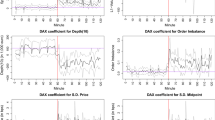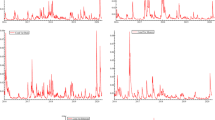Abstract
A fundamental question that arises in derivative pricing is why investors trade in a particular derivative at a “fair” price supplied by Arbitrage Pricing Theory (APT). APT establishes a price that is fair for a disinterested investor with a particular set of beliefs about market evolution and attributes trading to differences in those beliefs entertained by the opposite sides of the transaction.
We present a model for an investor in a frictionless market that combines investors’ incentives in the form of pre-existing liability structures with derivatives pricing procedure tailored for a particular investor. This model enables us to show, through a series of experiments, that investors trade even when their belief structures are identical and accurate.
More generally, our study suggests that multi-agent simulation of a financial market can provide a mechanism for conducting experiments that shed light on fundamental properties of the market. As all processes in financial markets (including decision making) become automated, it becomes crucial to have a mechanism by which we can observe the patterns that emerge from a variety of possible investor behaviors. Our simulator, designed as a dealer’s market, provides such a mechanism within a certain range of models.
Similar content being viewed by others
References
W.B. Arthur, J.H. Holland, B. LeBaron, R.G. Palmer and P. Tayler, Asset pricing under endogenous expectations in an artificial stock market, in: The Economy as an Evolving Complex System II, eds. W.B. Arthur, D. Lane and S.N. Durlauf (Adisson-Wesley,Menlo Park, CA, 1997).
F. Black and M. Scholes, The pricing of options and corporate liabilities, Journal of Political Economy 81 (1973) 637–654.
J.M. Harrison and S.R. Pliska, Martingales and stochastic integrals in the theory of continuous time trading, Stochastic Processes and their Applications 11 (1981) 215–260.
IBM Optimitation Solutions and Library, http://www-3.ibm.com/software/data/bi/osl/index.html.
R.A. Jarrow and S.M. Turnbull, Derivative Securities (International Thomson Publishing, Cincinnati, OH, 1996).
S. Joshi, J. Parker and M.A. Bedau, Technical trading creates prisoner’s dilemma: Results from an agent-based model, in: Computational Finance, eds. Y.S. Abu-Mostafa, B. LeBaron, A.W. Lo and A.S. Weigend (MIT Press, Cambridge, MA, 1999).
I. Karatzas and S. Shreve, Methods of Mathematical Finance (Springer-Verlag, New York, 1998).
A. King, Duality and martingales: A stochastic programming perspective on contingent claims, Mathematical Programming (2001). Published online; available at http://link.springer.de/link/service/journals/10107/first/bibs/s101070100257.htm.
A. King and L. Korf, Martingale pricing measures in incomplete markets via stochastic programming duality in the dual of L∞ (2002).
B. LeBaron, Agent-based computational finanace: Suggested readings and early research, Journal of Economic Dynamics and Control 24 (2000) 679–702.
B. LeBaron, A builder’s guide to agent-based financial markets, Quantitative Finance 1 (2001) 254–261.
B. LeBaron, W.B. Arthur and R.G. Palmer, The time series properties of an artificial stock market, Journal of Economic Dynamics and Control 23 (1999) 1487–1516.
Multi-Agent financial market simulator, http://www.cs.umbc.edu/~streltch/mafimsi.html.
R.G. Palmer, W.B. Arthur, J.H. Holland and B. LeBaron, Artificial economic life: a simple model of a stock market, Physica D 75 (1994) 264–274.
F. Partnoy, FIASCO The Inside Story of a Wall Street Trader (Penguin Books, New York, 1997).
S.R. Pliska, Introduction to Mathematical Finance: Discrete Time Models (Blackwell Publishers, Malden, MA, 1997).
J. Rust, Dealing with the complexity of economic calculations, 1996. Workshop on Foundamental Limits to Knowledge in Economics.
O. Streltchenko, T. Finin and Y. Yesha, Multi-agent simulation of financial markets, in: Formal Modeling in Electronic Commerce, eds. S.O. Kimbrough and D.J. Wu (Springer-Verlag, 2005).
O. Streltchenko, N.C. Narendra and Y. Yesha, A reference architecture for multi-agent simulation of derivatives markets, in: Proceedings of the International ICSC Congress on Computational Intelligence: Methods and Applications (Bangor, Wales, 2001).
Author information
Authors and Affiliations
Corresponding author
Rights and permissions
About this article
Cite this article
King, A.J., Streltchenko, O. & Yesha, Y. Using multi-agent simulation to understand trading dynamics of a derivatives market. Ann Math Artif Intell 44, 233–253 (2005). https://doi.org/10.1007/s10472-005-4689-6
Issue Date:
DOI: https://doi.org/10.1007/s10472-005-4689-6




